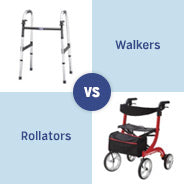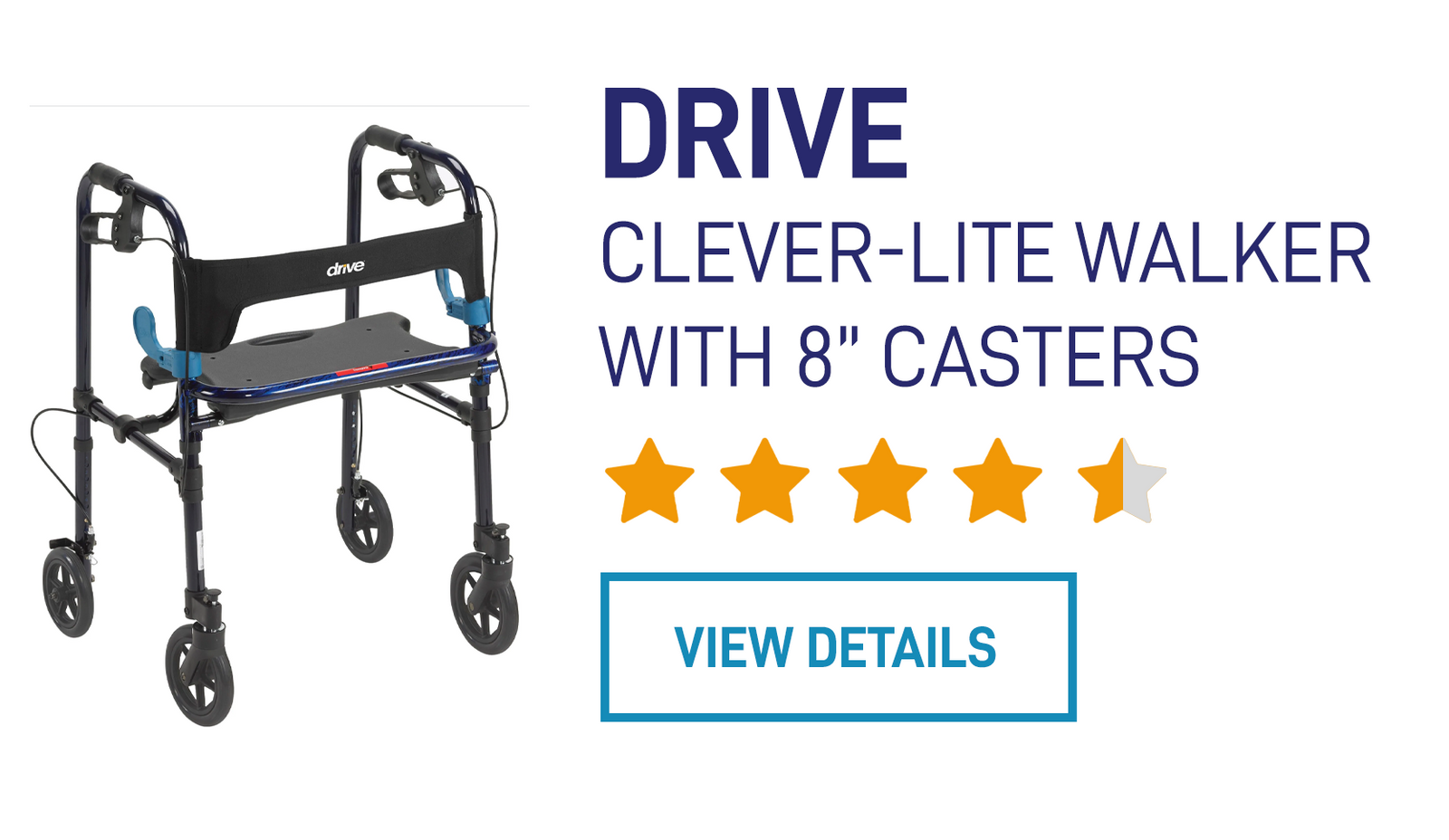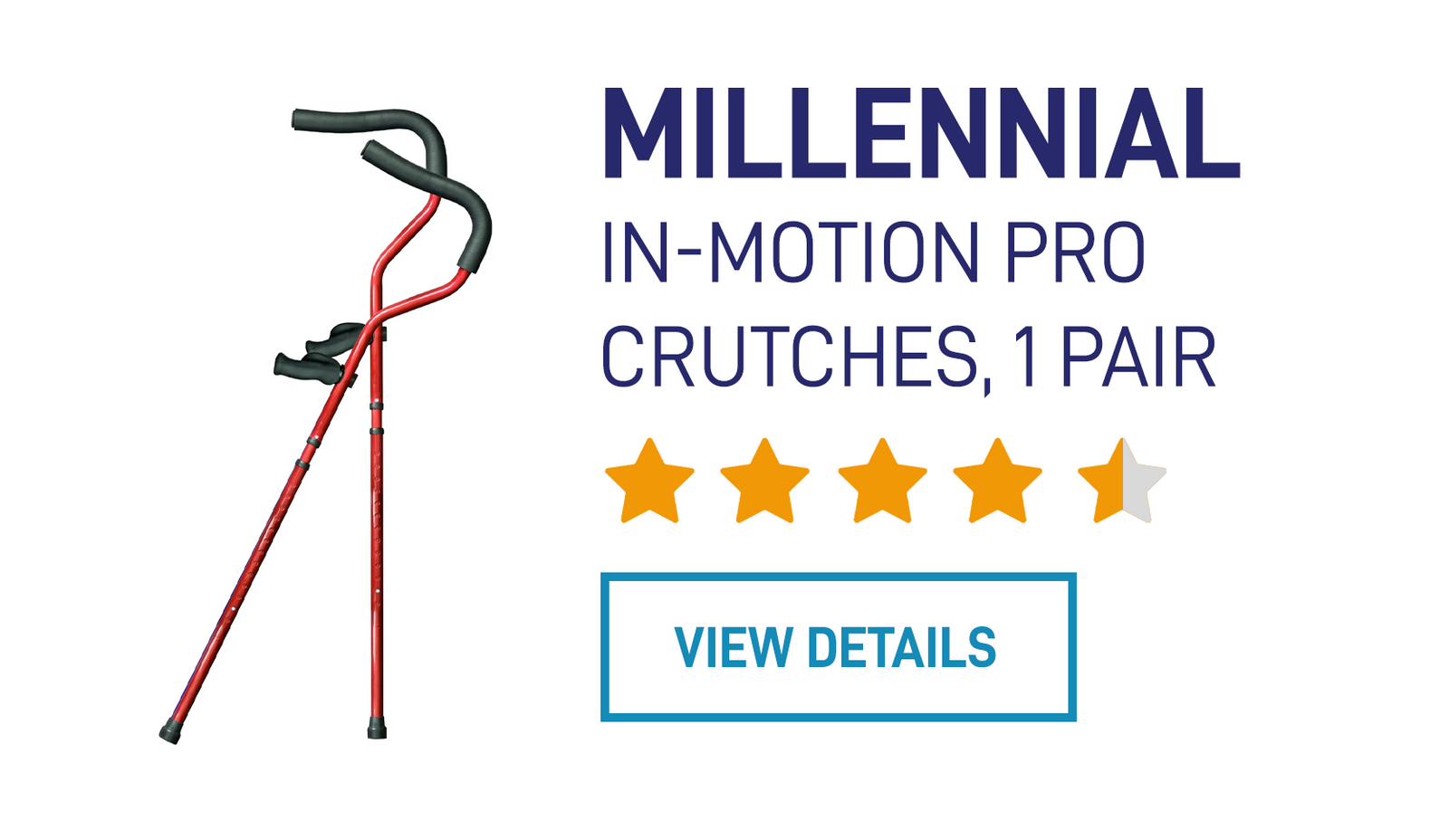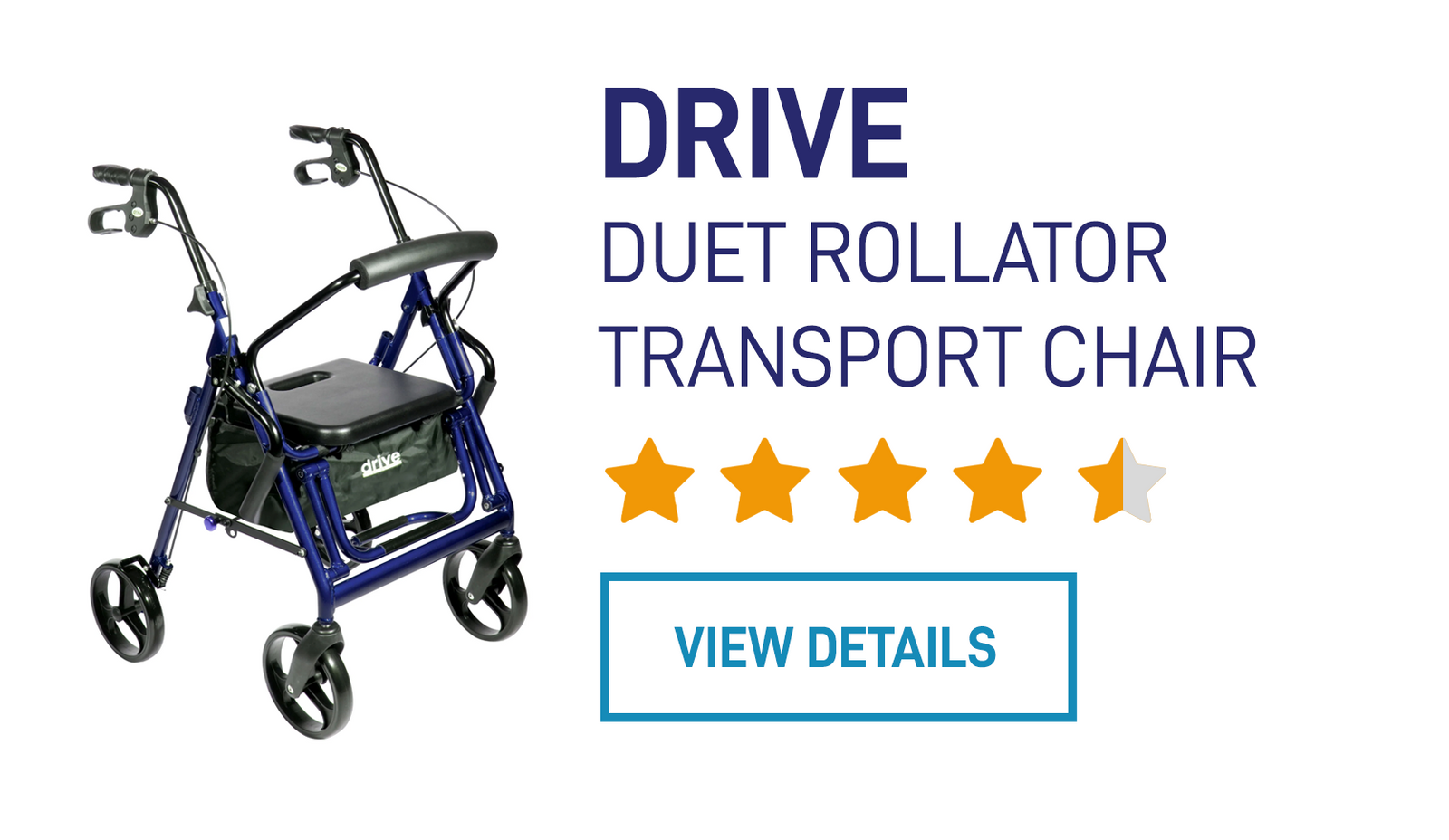Your Cart is Empty
Tips & Advice Center: Walker Tips

Buyer's Guide to Walkers >>
Comparing Walkers and Rollators >>
Walkers vs Rollators >>
Walkers: Wheels or No Wheels? >>
How To Use a Walker >>
How to Measure for a Walker >>
What to Look for When Buying a Walker >>
Who Needs a Walker? >>
4 Ways to Make Life Easier When Using a Walker >>
Any Further Questions? >>

Buyer's Guide to Walkers
Walkers come in many shapes and sizes. Here is a brief overview of the main types:
- Standard Walkers– Also known as a medical walker. Standard walkers are popular because they provide the most support of any mobility device. They must be lifted to move, and so require the user to have some upper body strength. Standard walkers can be difficult for long trips because it is quite tiring to lift it for every step. They also slow the user down substantially.
- Rolling Walkers – A rolling walker is one with wheels. The wheels can be front-only or on the front and the back, but never the back alone. Rolling walkers can allow the user a faster pace because they do not need to be lifted with each step. They are somewhat less stable than a standard walker, but still quite effective. Rolling walkers are a good option for someone who wants the extra support but plans on walking outside or moving more freely.
- Rollators – "Rollator" is another name for a four wheel walker. They always have brakes to help users stabilize them and are great for outdoor use. They allow the user to move as quickly as is safe because they are not slowed by having to lift. Most come equipped with some kind of basket or bag to hold personal items.
- Folding Walkers – A folding walker is one which is collapsible. Most walkers do fold for easy transport and storage.
Walker accessories make your life easier. Most of them are designed to carry items for you while you deal with only the walker or rollator.
- Walker Glides – Walker glides are smooth walker feet that can be dragged across the ground during use. They are often the first thing to wear out on a walker and need to be replaced often. Consider upgrading to a ski glide if your original glides are wearing quickly. Walker balls can also replace glides in some circumstances.
- Walker Bags – A walker bag or basket is the post popular type of accessory. They carry personal belongings while the user's hands are tied up by the walker.
- Walker Trays – Walker trays are another popular accessory. They are perfect for transporting food and drink safely and easily.

Comparing Walkers and Rollators
When comparing walkers and rollators, it is important to keep in mind that in most cases, either option will work. The differences come down to comfort, convenience, and price. Most people are provided a walker by their insurance company or Medicare/Medicaid, but that does not make it their best option. Walkers provide the most support to a user, but they are often cumbersome. Some active people may skip using their walker indoors or for short trips because it slows them down. This can lead to a higher chance of falling.
Rollators are often a better option for active users who value their mobility and independence. Rollators are much easier to use because they have wheels at the bottom of each leg. Rollators come in three and four wheel options.
Three wheel rollators are great for those who need to navigate tight spaces. They have a tighter turning radius and can be folded to fit through narrow doorways. Most three wheel rollators come with some sort of pouch, making it easy to carry your things. Four wheel rollators often come with a seat, or can have one attached. Three wheel rollators, however, cannot accommodate a seat. If a resting area is important to you, you should be considering a four wheel rollator.
Four wheel rollators are perfect for long trips and outdoor excursions. They are wider than a three wheel rollator or walker and provide a convenient seat. They often have larger wheels, which makes them easier to push over uneven surfaces like sidewalks. They also can accommodate pouches or baskets under the seat.
One of our most popular products is a combination rollator/transport chair. This can be used as both a traditional rollator, providing support to the person pushing it, or as a transport chair, offering the user a chance to sit back and relax as a caregiver pushes. This option is especially popular for travel because it offers the most flexibility. If you do not choose a rollator/transport chair, it is important to be aware that the seat of a traditional rollator is ONLY for resting, not for being transported.

Walkers vs Rollators
While walkers and rollators are quite similar, they both have their distinct purpose and style.
- Are very common
- Are lightweight
- Offer maximum support for walking
- Work well indoors
- Must be lifted to navigate even slightly uneven surfaces like thresholds
- Are walkers with wheels at the bottom of each leg
- Weigh slightly more than walkers
- Are easy to push
- Are the ideal solution for outdoor use
- May offer a seat for resting
Commonly, active adults in need of a long term walking aid prefer rollators while those in recovery who need more support prefer a medical walker.

Walkers: Wheels or No Wheels
When purchasing a walker, one of your biggest decisions is whether or not to get wheels. While many traditional walkersdo not have wheels, this is not necessarily the best option. Non-wheeled walkers can be cumbersome and difficult to use. Here are some points to consider when choosing a walker:
- Walkers without wheels offer the most support.
- If you have a walker without wheels, you must lift it to move forward. It will get caught on uneven surfaces such as thresholds or high pile carpet if not lifted.
- Walkers with front wheels are better equipped to accommodate uneven surfaces.
- Wheels add about one inch to the overall width of the walker.
- Four wheeled walkers should include brakes to make it easier to slow and stop.
- The most important part of owning a walker is your constant use of it. If it is too heavy, too cumbersome, or too wide, you need another option. It should feel like a natural extension of you. It is there to support you, after all.

How to Use a Walker
To start, make sure your walker is adjusted to the correct height. When you are standing up straight, your walker hand grip should line up with the crease in your wrist. When you grasp the handles, you should have a slight (about 15 degree) bend in your elbow.
To take your first step, place the walker about one step ahead of you. You should be able to keep your back straight throughout the movement. Next, step one leg inside the walker. You should not be touching the front bar. Step forward with your other leg to complete the step. Continue pushing the walker forward and walking up to meet it. Soon, this movement will become easy and natural. Remember, never use a walker on stairs or an escalator.

How to Measure for a Walker
When preparing to buy a walker, you need to make sure it can accommodate your height, especially if you are very tall or short. You may need a special petite walker, or walker leg extensions. Get a friend or family member to help you measure yourself.
- Start by standing up straight with your shoes on.
- Allow your hands to hang naturally at your sides.
- Measure from the crease in your wrist to the floor.
- This length should be your handle height.
- If possible, choose a walker that adjusts at least one inch higher and lower than your actual measurement so you can adjust it as necessary.

What to Look for When Buying a Walker
There are several factors that go into buying a walker. Besides the obvious style and cost factors, here are a few things to consider:
- Width – The overall width of a walker is especially important. Many homes have narrow bathroom doors. A standard bathroom door is only 22" wide. Public bathroom stall doors are also narrow. Other space considerations include hallways, trunk storage space, and travel requirements.
- Overall Walker Weight – Since you need to lift a traditional medical walker to move it, you want to make sure you can lift it easily. Also, remember that you will have to be able to place it in the trunk of your car or behind your seat to stay mobile. A heavy walker is more of a problem than a walking aid.
- Adjustable Height – All the walkers we carry are adjustable height, but make sure you choose one where you are in the middle of the height range. Different shoes and surfaces can change the height you need your walker to be, so you want to have room to adjust as possible.

Who Needs a Walker?
Often people wonder, as they or their loved one ages, whether it is time to acquire a walker. While a walker is not the first step, here are some clues that you or your loved one may need some mobility assistance.
As people age, core strength and balance deteriorate. Arthritis can set in to knees and hips. Also, medications or dietary changes can affect balance. Falls are the leading cause of injury for older adults. The right mobility aid is there to help, and the right item can save lives.
Usually the first item people look for is a cane. They are simple to use and readily available. This is a good first step, but canes only offer minimal support. A walker or rollator is far more helpful for those who have trouble rising. A walker can help the rising process and is a better support for preventing falls. Using a walker around the house can help a person stay in their home longer, as it helps to ensure they will be safe.
If one needs more support but doesn't want to be slowed down by a walker, a rollator may be the perfect solution. With four wheels on the ground, they roll easily and can move as quickly as needed. Rollators fold up for easy transport and most come with a basket or bag to carry belongings.

4 Ways to Make Life Easier When Using a Walker
- Make sure you are properly accessorized. Generally, a standard walker alone is not enough. Since your hands will be occupied, you will want something to help you carry your belongings. A walker pouch or basket can help. Also, you will want something to carry your drinks and meals. Walker trays can accommodate both, and cup holders can ensure that you will get the fluids you need throughout the day. Having your walker properly accessorized makes life much easier.
- Upgrade your glides. Glides are what allow you to push your walker effortlessly. They are also the first item to wear out on a standard walker. For walkers that are used outside, traditional walker glide caps can degrade in weeks. Upgrading your glides to a new ski glide with a raised front lip will help you cruise over obstacles easily. They also wear better and are easy to change. For indoor walkers, tennis ball glides can make it easier to use your walker. They are not meant to hold up to rough surfaces like cement, but they are great for hardwood or linoleum and they will not leave scratches.
- Carry a cane. Sometimes, you need to squeeze through small spaces like pantries or bathroom doors. For times when a walker is impractical, having a cane handy will allow you to move without fear of falling. Canes are also useful for navigating stairs, providing support as you go. You never want to be without your mobility aid, so make sure you have a backup when necessary.
- Consider purchasing a rollator. Overall, rolling walkers are easier to use than standard walkers. They easily roll over obstacles. They include a bag or basket to carry belongings. Many rollators also feature a seat so you have a place to rest when necessary. Rollators tend to be heavier than walkers, but they are great for adults who want to remain active; they can be used without slowing down as is often necessary with a walker.

Any Further Questions?
If you didn't find the answer you were looking for, feel free to call us toll-free at 1-888-986-0660. Our highly-trained staff is waiting to hear from you every weekday from 8:00 AM to 6:00 EST. You can also email us through the form found here.




